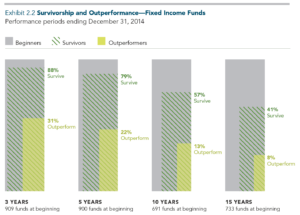There are different styles of mutual fund investing. Some fund managers pick and choose securities (stocks, bonds, etc.). Other fund managers simply buy big baskets of types of securities. The former is a more “active” approach to investing, the latter is a more “passive” approach.
Over the last decade, passive investment management has gained a strong foothold in the financial community. Fees and expenses are generally lower. Taxes are typically lower as well.
The argument for active investment management is still alive and well however. Active fund managers argue their skill at picking the best stocks or bonds. They claim the ability to “duck and dodge” their way around bad markets.
Active fund managers believe they alone have the “secret sauce” to higher returns. Do the facts play out this way? Let’s dig into the active/passive investment management debate.
Understanding the efficient market hypothesis
The first thing you need to understand is EMH, or the efficient market hypothesis. EMH is the theory that securities are always fairly valued, and that investors cannot know more than the collective wisdom of the masses.
Information is readily available in this day and age. Since millions of investors all have the same information, all available information is already built into the price of a security. Since all available information is built into the price of a security, all securities are always fairly valued.
For example, financial expectations are already built into the price of a stock. Interest rate expectations are already built into the price of a particular bond. All securities are fairly valued at all times.
The core premiss of the efficient market hypothesis, is if all securities are always fairly valued, one investor cannot know more than the next. If one investor cannot know more than the next, there is no point in picking individual stocks or bonds.
What is active investment management?
Active investment managers DO NOT believe in the efficient market hypothesis. To the contrary, they believe it is possible to outguess the markets and it’s millions upon millions of investors.
First and foremost, active investment managers attempt to produce the highest returns possible. Secondly, they seek to beat a given index or benchmark. If you can’t beat the benchmark index, why would investors pay more to have you manage their funds after all?
Active investment strategies may invest in stocks, bonds, or commodities. Most any investment you can think of has a mutual fund which can provide broadly diversified exposure.
Actively managed mutual funds delve even deeper into smaller “sub-sections” of the capital markets. Some mutual fund managers may invest in small cap stocks, emerging markets, or high yield bonds. Their target investment exposure is detailed in the mutual fund fact sheets, and the fund prospectus. Whatever the target investment class or sector may be, actively managed mutual funds use varying strategies to produce the best investment return possible.
They do this by picking and choosing which securities to invest in. They search for undervalued investments, hoping the rest of the world will eventually realize what they think they know.
Active investment management also engages in market timing. They may lighten up on securities – or go to cash altogether – in anticipation of a market drop. They’ll buy back in when they think the market conditions will improve. Market timing is an attempt to gain an advantage, hoping their predictions for the future come true.
What is passive investment management?
Contrary to active investment management, passive investment managers do believe in the efficient market hypothesis. They DO NOT try to beat their respective benchmark index through security selection or market timing. Rather, a passive investment manager will accept investment returns for a given asset class.
A passively managed mutual fund will invest in a large group of securities. They do this with blinders on. They don’t pick and choose which bonds or stocks to invest in, or time the markets. They simply buy a whole lot of securities which fit a certain criteria.
That criteria may be “all large cap stocks” like the Russell 1000 index. It may be all investment grade bonds in the US, like the Barclays Aggregate Bond Index. No matter what the target investment grouping may be, a passively managed fund will simply buy a large group of securities which meet the criteria.
What is an index fund?
Index funds are a subset – or type – of passive investment management. While index funds are passive by nature, they’re limited in what they can invest in because they must mimic some index. This makes them different than passively managed mutual funds.
The S&P 500 index is a group of the 500 largest companies in the US. While it represents a good section of US large cap companies, it’s only 500 stocks. A similar passively managed large cap fund may own 600, 700, or more stocks.
Index funds are limited. They must provide the investor the returns and yield of a given index within reason. Passively managed funds aren’t limited by the index requirements. They outperform and underperform their benchmark index regularly.
Since passively managed funds aren’t limited, they have greater flexibility to manage their portfolio. They may add value tilts, profitability tilts, and other portfolio “tweaks”. By implementing these portfolio “tweaks”, the fund manager seeks to “juice up” investment returns over and above their benchmark index.
One such passive investment manager is Dimensional Fund Advisors. DFA mutual funds tilt and tweak their mutual funds to increase returns. Rather than being hamstrung to mirroring an index, they have that flexibility to seek higher investment returns.
So what’s better? Active or passive investment management?

Accepting market – or asset class – investment returns is superior. Over any given asset class (stocks, bonds, commodities, etc.) – or any subset thereof (emerging markets, international, technology, etc.) – active investment management fails to outperform passive overwhelmingly.
Investing is a long term proposition right? If you’re a short term investor, you may as well head down to your local casino. Your chances are better playing roulette!
Since investing is a long term process, passive investment management is superior.
For bond funds, roughly 2/3 of active fund managers fail to beat their benchmark index. Since they can’t beat the benchmark, is it really worth trying?

And if bond fund managers can’t beat their benchmark index, what about stock fund managers? Can they beat their benchmark index?

By and large, active stock funds can’t beat their benchmark index either.
Let me explain the charts above. They’re screenshots from the “2015 Mutual Fund Landscape” put out by DFA (Dimensional Fund Advisors). The charts illustrate in grey ALL mutual funds for the time periods noted. For example, there are 4,277 actively managed stock funds illustrated in grey with a 3 year track record.
Digging a bit deeper, there are only 4,255 funds with a 5 year track record, 2,955 with a 10 year track record, and 2,711 with a 15 year track record. You’re probably wondering why there’s only about half the mutual funds with a 15 year track record, compared to the number with a 3 year track record. The answer is simple, and it’s called survivorship bias.
Survivorship bias
Mutual funds which stink fail to survive because they stink! They get merged into bigger funds which don’t stink (don’t stink as bad anyway). Sometimes they get liquidated and distributed to shareholders.
When funds disappear, the surviving mutual funds look better than they actually are. For example, let’s say your large cap stock index fund ranks top 30 out of 100 competitors. In 5 years, 20 competitors die off or get merged into other funds. Now that 30th percentile ranking becomes a 37th percentile ranking (30 divided by 80).
Your index fund was good, and continued to do well. However, since the crummy funds were wiped out, the field of competitors narrowed. Your index fund ranking looks worse that it is in reality. It’s performance ranking was actually penalized simply because it survived and other mutual funds did not.
This is called survivorship bias. The truth is, passively managed mutual funds would outperform even more than they already do, if they weren’t penalized for crummy mutual funds flunking out!
Back to the active/passive performance charts
For stock funds, you can see about a third of actively managed funds outperform the benchmark index for the 3 year period. About a quarter outperform for the 5 year period, and about a fifth outperform for the 10 and 15 year timeframes. Bond funds aren’t much better. In fact they’re almost identical in performance.
What does this all mean to you? If you’re invested in an actively managed mutual fund, you’ve got about a 20% to 30% chance of beating it’s benchmark index. That’s not so hot is it!
In fact, looking at these numbers isn’t it foolish to invest in actively managed mutual funds? Active management just doesn’t work. Your odds of successfully beating the passive benchmark index are quite low.
But what about the 20% to 30% which outperform?
Some managers will outperform over a given (short) period of time. This is simple statistics. By default, some active managers must get lucky statistically.
Active managers will not outperform the index in any predictable fashion however. They also will not outperform for longer periods of time. The charts above prove it, and the numbers don’t lie.
Active/passive investment management summarized
If active investment management doesn’t consistently beat it’s benchmark – why bother trying? It’s possible you MAY get lucky and get the “hot hand” mutual fund manager. Clearly the odds are stacked against you. You’re far more likely to end up underperforming a simple benchmark.
Active management fund fees are higher, their turnover is higher, there is less tax efficiency, and they don’t outperform their benchmark index. For these reasons it’s prudent to invest in passive investment strategies.
Accept market returns. Keep your fees and expenses low. Minimize your taxes. These tried and true strategies are far more important to your financial success than trying to pick the next hot fund manager.
